Carnac › Carthage › A Visual Who's Who of Greek Mythology » Origins and History
Articles and Definitions › Contents
- Carnac › Origins
- Carthage › Origins
- A Visual Who's Who of Greek Mythology › Origins
Ancient civilizations › Historical places, and their characters
Carnac › Origins
Definition and Origins
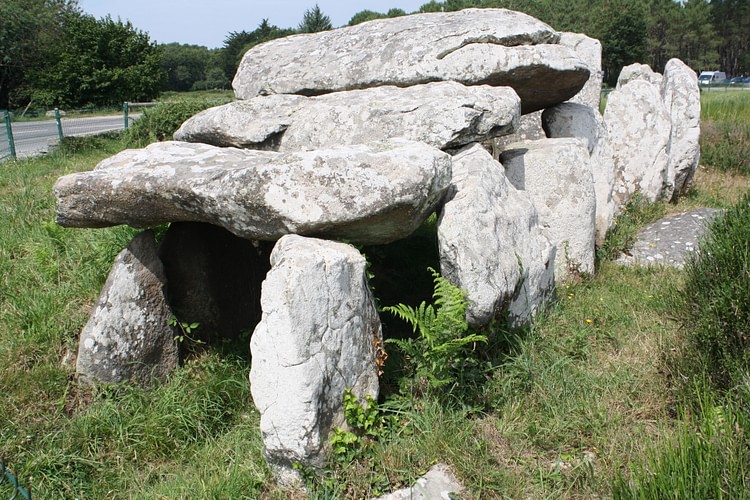
Carnac, located on the north-west coast of France, is the site of the largest concentration of megalithic monuments in the world. Over 100 monuments, which include burial mounds, stone tombs, enclosures, and linear arrangements of menhirs, were erected between the 5th and 3rd millennia BCE by the Neolithic farming communities which inhabited the area of Carnac.
ARRANGEMENTS
The granite stones (megaliths), varying in size from 1 metre in height to huge 6.5 metre tall stones weighing several hundred tons, were removed (not quarried) from rocky outcrops in the surrounding area. The stones were most probably moved using levers and rollers and those stones positioned on top of others were dragged up an artificial earth incline made level with the top of the vertical stones with the earth then being removed when the construction was complete. The stones were placed in several types of arrangements:
- Menhirs - single free-standing stones, often roughly dressed and placed within a shallow hole and on a wedge stone for stability.
- Mounds - individual tombs, also known as a tumulus.
- Dolmens - collective tombs composed of upright stones topped by horizontal stones and dry masonry, sometimes with an entrance passage and originally covered by either an earth mound preserving the access passage or a barrow with no access to the inner tombs.
- Enclosures - a circle or defined space bordered by stones and closed off by adjoining or closed megaliths.
- Alignments - parallel rows of single upright stones sometimes stretching several hundred metres. Often set in more or less straight lines but sometimes curving and even slightly changing in angle at certain points in the lines.
- Cairns - piles of smaller stones, typically built over a burial site.
KEY EXAMPLES
St. Michael's Barrow, measuring 125 x 60 metres and 12 metres high, is the largest burial mound at the site. Its name derives from the chapel built in modern times on its summit. Excavations within the inner burial chamber placed 8 metres down have revealed many artefacts now in the museum of Prehistory in Vannes. These include shell pendants, beads, more than 40 axe-heads of either green jadeite or white fibrolite, and 97 pearls. Secondary and more comprehensive excavations revealed a small dolmen at the west end of the mound and a larger tomb in the centre which was itself surrounded by 15 irregular graves containing cattle bones. Carbon dating places the construction of the barrow as early as 6,000 BCE.

Neolithic Variscite Necklace
The Kerlescan Mound has a 3.7 metre high marker stone on top, a common feature of such structures. Finds within the mound date to 2,200 BCE and include pottery and a copper axe. The Er Mané Barrow takes an unusual oval form and measures 35 x 23 metres and stands 12 metres above the surrounding area. Once again a menhir has been placed on the top, this one measuring 2.8 metres high. Yet another example of the barrow form is the Le Manio Barrow which measures 37 x 10 metres and is topped by a massive 6.5 metre menhir known as the Manio Giant. The large stones within the structure display serpent-like carvings.
Of the 50-plus dolmen scattered around Carnac the most celebrated is the Crucuno Dolmen with its classic arrangement of a circle of giant stones topped by a massive 40-ton stone slab. The dolmen's burial chamber measures 3.5 metres across and is 1.8 metres high. Originally, there was also a 24 metre long entrance corridor composed of standing stones but these, like so many of Carnac's structures, were plundered so that the stones could be re-used in modern buildings.
One of the few dolmen with its original earth mound above and still with a 6.5 metre long stretch of its entrance tunnel is the dolmen near the Kermario section of the alignments which was built c. 4,600-4,700 BCE. Measuring 25 metres in diameter and standing 5 metres tall the structure once had an impressive ring of stones around the entire circumference but only those stones on the south-west side survive. The stone slabs within the structure were carved to show geometric and axe head designs. One large stone in the inner chamber takes the form of a shield which is a feature of dolmen throughout the region and considered to represent a mother-earth goddess. Artefacts excavated from within include pottery, axes, beads and flint arrowheads, many dating to c. 2,000 BCE and illustrating that the structure was used over millennia.
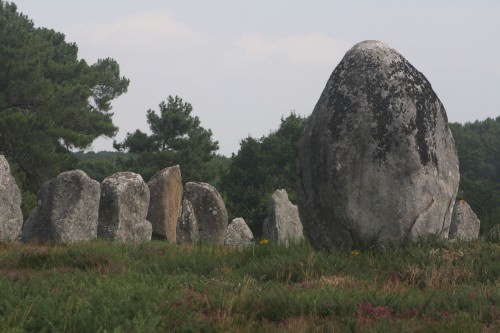
Carnac Alignments
Perhaps the best dolmen without its barrow is the one situated at the confines of the Kermario alignments. Measuring 8.7 metres in length, four of the stone slabs of the roof remain along with a short section of the entrance passage. Examples of dolmen which contain inner compartmentalised chambers are the Keriaval Dolmen which actually has two lateral chambers, at Mané Groh with its four inner chambers, and the rectangular Clud-er-Yer Dolmen. Finally, the several dolmens near the Kerlescan alignments are good examples of less common burial chambers with a secondary side entrance.
The long parallel rows and semi-circular arrangements of large upright menhirs which stretch 15 km across the fields of Carnac are known simply as the Alignments. The thousands of stones have suffered all manner of interference over the years.Some have been moved by farmers to avoid archaeologists interfering in their livelihood, many have been stolen, roads and car parks have been constructed through them, over 50 were used to build a lighthouse and not a few have fallen on their sides. Still, enough survive to create an impressive panorama of a pre-meditated scheme of placement. The most complete group is at Le Menec where there are eleven rows of stones, each stone decreasing in size moving towards the east and terminating at each end in a large stone circle. The circle at the western end was originally constructed using around 70 stones. The best surviving enclosure, though, is with the Kerlescan alignment section where there is a 240 x 200 metre space surrounded by large upright stones placed very close together. Excavations within the alignments have revealed finds of pottery, flints and hearths.
PURPOSE
The exact significance of the stones, especially the alignments, has been much debated for centuries. Local people long-regarded the megaliths as magical, Boureau Deslandes thought that they had occurred naturally following 'upheavals suffered by the Earth', and the writer Gustave Flaubert famously dismissed them as merely 'large stones'. Early scholars considered them examples of Celtic temples or assembly points for the ancient druids of Armorica or even maps of celestial bodies. One of the most picturesque theories, according to the legend of St. Cornely, was that the huge stones were a transformed army of Roman legionaries who had unwisely tried to attack the Saint.
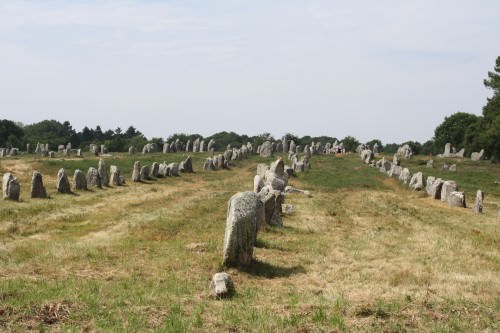
Carnac Alignments
More scientific investigation began in the 19th century CE with the Scotsman J.Miln who studied the megaliths and opened a museum of Prehistory in the small town of Carnac. Miln's work was continued by his student Zacharie Le Rouzic who also ensured the stones were protected for future generations. Their work, and that of those who followed, has shed a little more light on the secrets of Carnac.
That the larger structures are examples of ancient burial architecture seems certain but these buildings may have also served as territorial markers. The structures could also have had a secondary purpose as a symbol and reinforcement of a group identity. The single free-standing stones of the alignments are much more mysterious but scholarly consensus defines them as most probably markers pointing to or highlighting the presence of a sacred site or significant burial place. The parallel lines of stones seem to define paths which converge towards certain enclosures which are themselves situated on higher ground. It has also been noted that the lines, stretching from east to west, follow the sunrise at the solstices. Therefore, taken together - the lines and enclosures - the entire area covered by seemingly haphazard stones becomes a purposely constructed layout of processional ways and sacred spaces, a pattern reproduced by many subsequent ancient civilizations for their sacred rites from the Minoans on Crete to the Nazca in South America.
Carthage › Origins
Definition and Origins
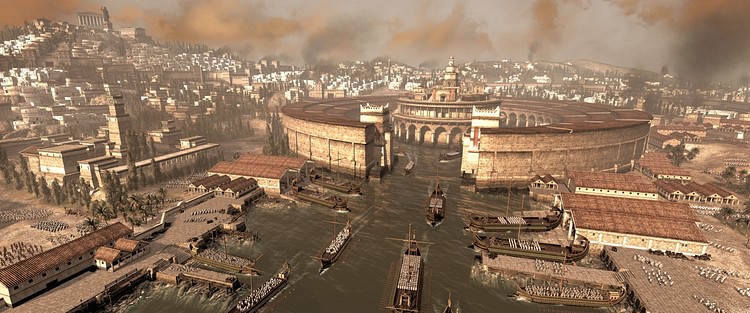
According to legend, Carthage was founded by the Phoenician Queen Elissa (better known as Dido ) sometime around 813 BCE although, actually, it rose following Alexander 's destruction of Tyre in 332 BCE. The city (in modern-day Tunisia, North Africa) was originally known as Kart-hadasht (new city) to distinguish it from the older Phoenician city of Utica nearby. The Greeks called the city Karchedon and the Romans turned this name into Carthago. Originally a small port on the coast, established only as a stop for Phoenician traders to re-supply or repair their ships, Carthage grew to become the most powerful city in the Mediterranean before the rise of Rome.
A GREAT TRADE CENTRE
After the fall of the great Phoenician city of Tyre to Alexander the Great in 332 BCE, those Tyrians who were able to escape fled to Carthage with whatever wealth they had. Since many whom Alexander spared were those rich enough to buy their lives, these refugees landed in the city with considerable means and established Carthage as the new centre of Phoenician trade. The Carthaginians then drove the native Africans from the area, enslaved many of them, and exacted tribute from the rest. From a small town on the coast, the city grew in size and grandeur with enormous estates covering miles of acreage. Not even one hundred years passed before Carthage was the richest city in the Mediterranean. The aristocrats lived in palaces, the less affluent in modest but attractive homes, while tribute and tariffs regularly increased the city's wealth on top of the lucrative business in trade. The harbour was immense, with 220 docks, gleaming columns which rose around it in a half-circle, and was ornamented with Greek sculpture. The Carthaginian trading ships sailed daily to ports all around the Mediterranean Sea while their navy, supreme in the region, kept them safe and, also, opened new territories for trade and resources through conquest.
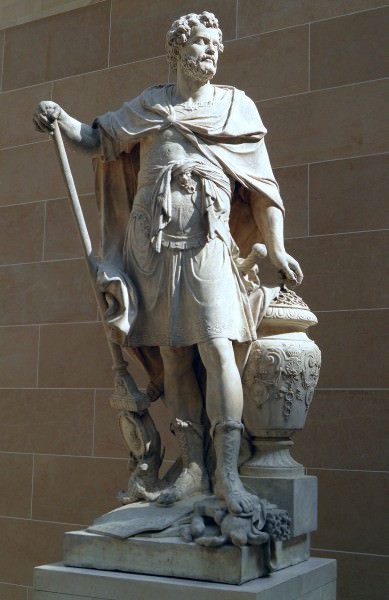
Hannibal Barca
CARTHAGE AGAINST ROME
It was this expansion which first brought Carthage into conflict with Rome. When Rome was weaker than Carthage, she posed no threat. The Carthaginian navy had long been able to enforce the treaty which kept Rome from trading in the western Mediterranean. When Carthage took Sicily, however, Rome responded. Though they had no navy and knew nothing of fighting on the sea, Rome built 330 ships which they equipped with clever ramps and gangways (the corvus ) which could be lowered onto an enemy ship and secured; thus turning a sea battle into a land battle. The First Punic War (264-241 BCE) had begun. After an initial struggle with military tactics, Rome won a series of victories and finally defeated Carthage in 241 BCE. Carthage was forced to cede Sicily to Rome and pay a heavy war indemnity.
CARTHAGE AGAIN WENT TO WAR WITH ROME WHEN THE GENERAL HANNIBAL ATTACKED THE CITY OF SAGUNTUM.
Following this war, Carthage became embroiled in what is known as The Mercenary War (241-237 BCE) which started when the Carthaginian army of mercenaries demanded the payment Carthage owed them. This war was finally won by Carthage through the efforts of the general Hamilcar Barca. Carthage suffered greatly from both these conflicts and, when Rome occupied the Carthaginian colonies of Sardinia and Corsica, there was nothing the Carthaginians could do about it. They tried to make the best of their situation by conquering and expanding holdings in Spain but again went to war with Rome when the Carthaginian general Hannibal attacked the city of Saguntum, an ally of Rome. The Second Punic War (218-202 BCE) was fought largely in northern Italy as Hannibal invaded Italy from Spain by marching his forces over the Alps. Hannibal won every engagement against the Romans in Italy. In 216 BCE he won his greatest victory at the Battle of Cannae but, lacking sufficient troops and supplies, could not build on his successes. He was defeated by the Roman general Scipio Africanus at the Battle of Zama, in North Africa, in 202 BCE and Carthage again sued for peace.
Placed, again, under a heavy war indemnity by Rome, Carthage struggled to pay their debt while also trying to fend off incursions from neighbouring Numidia. Carthage went to war against Numidia and lost. Having only recently paid off their debt to Rome, they now owed a new war debt to Numidia. Rome was not concerned with what Carthage and Numidia were involved with but did not care for the sudden revitalization of the Carthaginian army. Carthage believed that their treaty with Rome was ended when their war debt was paid; Rome disagreed. The Romans felt that Carthage was still obliged to bend to Roman will; so much so that the Roman Senator Cato the Elder ended all of his speeches, no matter what the subject, with the phrase, “Further, I think that Carthage should be destroyed.” In 149 BCE, Rome suggested just that course of action.
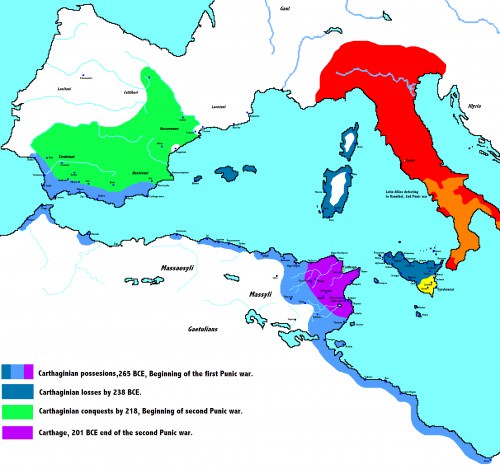
Carthage during the Punic Wars
THE DESTRUCTION OF CARTHAGE
A Roman embassy to Carthage made demands to the senate which included the stipulation that Carthage be dismantled and then re-built further inland. The Carthaginians, understandably, refused to do so and the Third Punic War (149-146 BCE) began. The Roman general Scipio Aemilianus besieged Carthage for three years until it fell. After sacking the city, the Romans burned it to the ground, leaving not one stone on top of another. A modern myth has grown up that the Romans forces then sowed the ruins with salt but this story has no basis in fact. It is said that Scipio Aemilianus wept when he ordered the destruction of the city and behaved virtuously toward the survivors.
Utica now became the capital of Rome's African provinces and Carthage lay in ruin until 122 BCE when Gaius Sepronius Gracchus, the Roman tribune, founded a small colony there. Memory of the Punic wars still being too fresh, however, the colony failed. Julius Caesar proposed and planned the re-building of Carthage and, five years after his death, Carthage rose again. Power now shifted from Utica back to Carthage and it remained an important Roman colony until the fall of the empire.
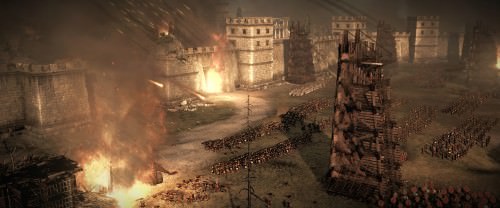
Siege Warfare
LATER HISTORY
Carthage rose in prominence as Christianity grew and Augustine of Hippo lived there before coming to Rome. The city continued under Roman influence through the Byzantine Empire (formerly the Eastern Roman Empire ) who held it against repeated attacks by the Vandals. In 698 CE, the Muslims defeated the Byzantine forces at the Battle of Carthage, destroyed the city completely, and drove the Byzantines from Africa. They then fortified and developed the neighbouring city of Tunis and established it as the new centre for trade and governorship of the region. Carthage still lies in ruin in modern day Tunisia and remains an important tourist attraction and archaeological site. The outline of the great harbor can still be seen as well as the ruins of the homes and palaces from the time when the city of Carthage ruled the Mediterranean.
A Visual Who's Who of Greek Mythology › Origins
Ancient Civilizations
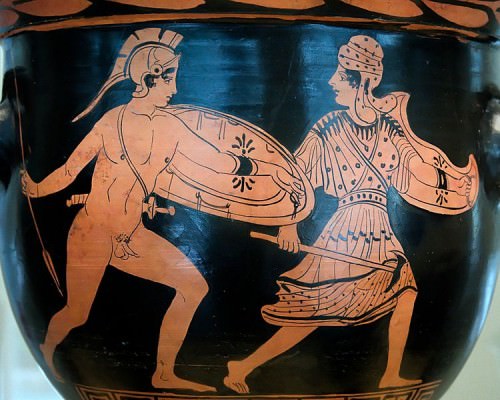
Achilles & Penthesileia
ACHILLES
The hero of the Trojan War, leader of the Myrmidons, slayer of Hector and Greece 's greatest warrior, who sadly came unstuck when Paris sent a flying arrow guided by Apollo, which caught him in his only weak spot, his heel.

Adonis
ADONIS
The impossibly handsome youth whom Aphrodite fell in love with. The goddess kept Adonis safe and sound in a chest guarded by Persephone, but she fell in love with him too and would not give him back. Zeus intervened and ruled Adonis should spend four months of the year with each lady. Tragically killed in a hunting accident he was transformed into a flower without scent. He may at once represent both the fertility and barrenness of the soil.
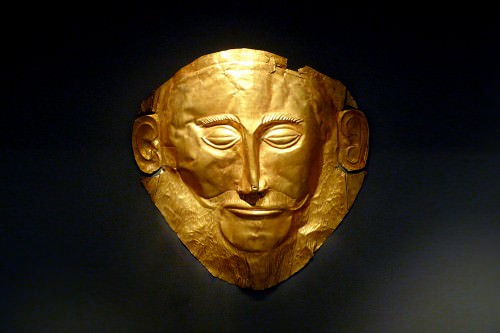
Death Mask of Agamemnon
AGAMEMNON
King of Mycenae and leader of the Greeks during the Trojan War, his leadership skills were only equalled by his selfishness, the latter famously upsetting Achilles when he stole the hero's female war -booty Briseis. After 10 years of war, the king was killed by his jealous wife Clytemnestra and her lover Aegisthus while he was enjoying his coming-home banquet. The famous gold Mask of Agamemnon from Mycenae, in fact, predates him by four centuries.

Aphrodite
APHRODITE
Goddess of love, beauty, and desire; her whisperings could derange both men and gods. She was especially worshipped on Cyprus, where she was believed to have risen from the foaming sea where Kronos threw the genitalia of his father Uranus.Unwilling wife of Hephaistos, she had famous flings with Ares, Hermes, and Dionysos.
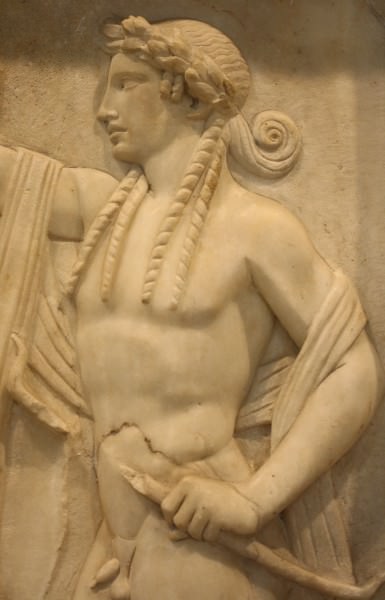
Apollo
APOLLO
Dashing and handsome, the son of Zeus and Leto was the god of healing and the arts. Twin brother of Artemis, his famous offspring include Orpheus and Asclepius. Often represented holding a lyre, he was immensely popular and had many temples and sanctuaries dedicated to him, notably at Delos and Delphi where his oracle dwelt.
ARACHNE
The talented Lydian weaver who foolishly challenged Athena to a sewing competition. Arachne does indeed produce a mesmerising cloth, but Athena loses her cool and destroys it. When the girl hangs herself as a consequence, the goddess transforms her into a spider so that she can go on weaving forever.
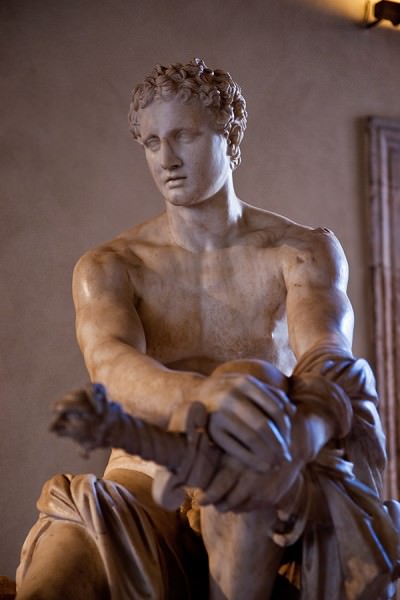
Ares
ARES
The unpopular and troublesome god of war with a quick temper and never-ending thirst for battle. Handsome and courageous, the son of Zeus and Hera was a bringer of doom but was especially popular in martial Sparta. His children were Phobos (Fear) and Deimos (Terror), who often accompanied him on the battlefield.

Hercules & Argonauts
ARGONAUTS
The group of heroes who sailed on the Argo with Jason in his quest for the Golden Fleece. The team included Hercules, Theseus, the Dioskouroi, Atalanta, Orpheus, and Meleager.
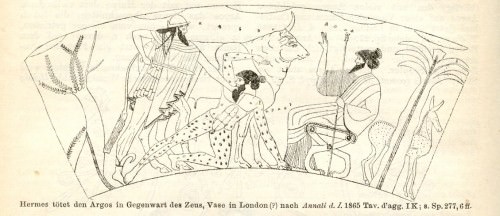
Argus Panoptes
ARGUS (AKA ARGOS PANOPTES)
The one-hundred-eyed monster of dubious parentage. Set to guard Io by Hera, the creature did not see his demise coming at the hands of Hermes.

Ariadne & Theseus
ARIADNE
The daughter of King Minos of Crete who helped Theseus escape the Minotaur 's labyrinth by giving the hero a ball of string so that he might fight the entrance again. Not getting much reward for her efforts she was shortly after dumped on Naxoswhere Dionysos picked her up to become the god of wine's consort.

Artemis / Diana
ARTEMIS
Goddess of hunting, fertility, wild animals, and childbirth, she was the daughter of Zeus and Leto, and twin sister of Apollo.Famously preferring a life of hunting to marriage, she had one of the Seven Wonders of the ancient world dedicated to her, the temple at Ephesos.
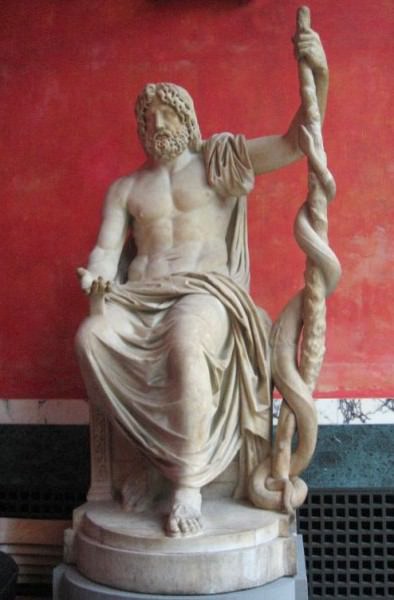
Statue of Asklepios
ASCLEPIUS
The god of medicine, he learnt his skills from his father Apollo and passed them on to such luminaries as Hippocrates. His medicinal skills were so effective that Zeus killed him with a thunderbolt for threatening the mortality of humanity. Asclepius' sanctuary at Epidaurus was famed throughout the ancient world and he is often depicted holding his staff ( bakteria ) with a sacred snake coiled around it.

Atalanta
ATALANTA
The hero huntress who accompanied Meleager on the Calydonian boar hunt. Her other achievements included slaying a pair of centaurs and beating Peleus at wrestling. Long a maiden, she only consented to marry the man who could beat her in a foot-race. Hippomenes won her hand by dropping apples on the track to distract Atalanta, but the pair's matrimony was short lived for, after making love in a temple of Zeus, they were punished by the god who transformed them into lions.

The Piraeus Athena
ATHENA
The maiden goddess of wisdom, war, and crafts, she was Zeus' favourite daughter and patron of Athens, which dedicated the Parthenon to her. In art, she often wears armour and a helmet pushed back on her head as in the silver coins of Athens.

The Farnese Atlas
ATLAS
The unlucky Titan who had to carry the heavens as a punishment from Zeus for leading the Titans against the Olympian gods in a failed attempt to control the universe. Father of many stars, including the Pleiades, he was Plato 's king of Atlantis.
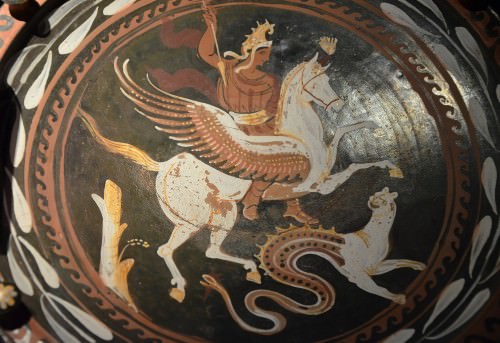
Bellerophon riding Pegasus and the Chimera
BELLEROPHON
The son of Poseidon who was famously tasked by King Proetus of Tiryns with slaying the Chimera. This monster with a lion's body, a snake for a tail, and the head of a goat sprouting from its back was killed by the hero who flew his winged horse Pegasus.

Cadmus Slaying the Dragon
CADMUS
The legendary founder of Thebes. Of Phoenician origin, he was sent to search for his sister Europa but, failing to find her, founded his city where a cow lay down, as instructed by the oracle of Delphi. He slew a dragon in the area and, sowing its teeth in the earth, he thus created the local population.

Calliope
CALLIOPE
The Muse of epic poetry and rhetoric. She is traditionally the most important of the nine Muses and is often depicted holding a writing tablet and stylus.

Centaur & Lapith Metope, Parthenon
CENTAUR
The half-horse and half-man creatures who, often drunk, represented passions unabated and unbridled chaos. Living in Thessaly, some could be wise such as Chiron, tutor of Achilles, Hercules, and Asclepius. A popular subject in art, they appeared on several metopes of the Parthenon.

Statue of Hades and Cerberus
CERBERUS
The ferocious three-headed hound of Hades which protected the entrance to the Underworld.
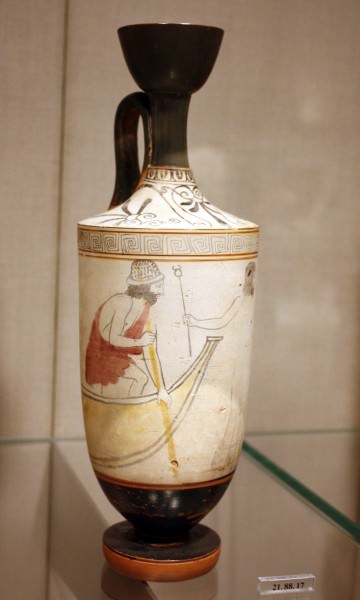
Attic Lekythos
CHARON
The ferryman who transports the souls of the dead across the river to Hades.

Charybdis
CHARYBDIS
The sea monster which haunted the straits between Sicily and the Italian mainland, later rationalised as a whirlpool.Odysseus managed to escape it by grabbing onto an overhanging tree.

Chimera
CHIMERA
The fire-breathing monster which is front-part lion with a snake's tail and the head of a goat on its back. Slain by the hero Bellerophon, it was the offspring of either Typhon and Echidna or reared by Amisodarus.
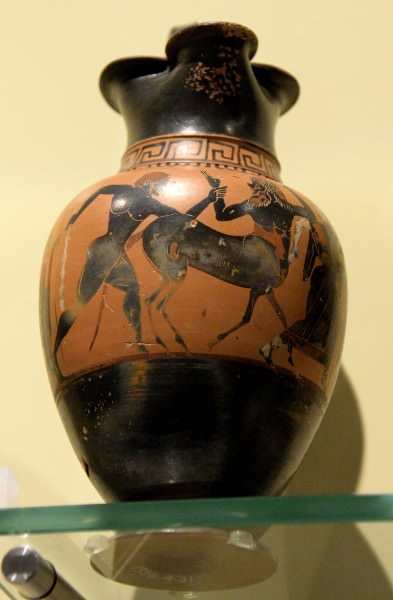
Oinochoe with Centaur
CHIRON
The wise centaur who tutored Achilles, Jason, and Asclepius. He was especially knowledgeable of medicine and is often portrayed carrying a ready snack of hares over one shoulder.
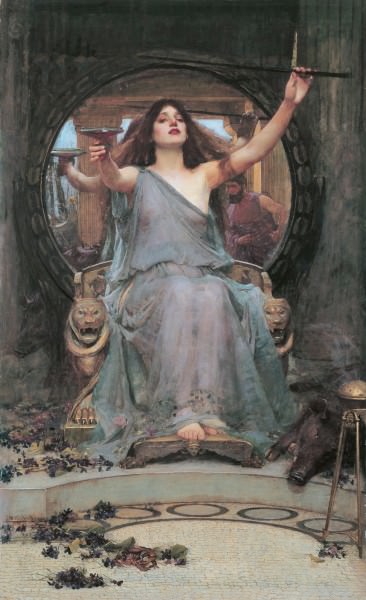
Circe
CIRCE
The sorceress daughter of Helios and Perse who changed Odysseus ' men into pigs. Although the hero himself could resist Circe's charms and magic by using the 'moly' plant, the group stayed on her island for a whole year, eventually acquiring useful advice for the perils of the journey home.

Clio
CLIO
The Muse of history and often depicted holding a scroll.
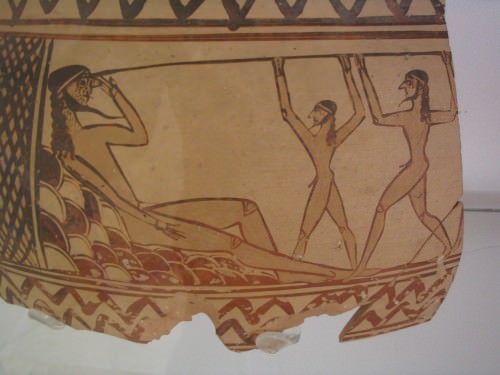
Odysseus Blinding the Cyclops
CYCLOPES
The one-eyed giants who live a savage, pastoral existence in a far off and unknown land. Hesiod describes three: Brontes, Steropes, and Arges, who are divine craftsmen, assistants to Hephaistos. Large Mycenaean fortification walls were credited to them, such was the size of the blocks used. Homer 's Odysseus famously visited them and was captured by one, Polyphemus (see below).

Daedalus & Pasiphae
DAEDALUS
He was the master craftsman who designed the Minotaur 's labyrinth at Knossos, the wooden cow for Minos' wife Pasiphae to attract the bull she had fallen head over heels for, and various automatons. He was also the father of the hapless Icarus.

The Punishment of the Danaids
DANAIDS
The 50 daughters of Danaus who, avoiding marriage with the 50 sons of Aegyptus, fled with their father to Argos. The girls were pursued, though, and, on their wedding night, Danaus instructed them to kill the 50 men. One girl did not, Hypermestra, and she founded the dynasty of Argos. As a punishment for the dreadful deed (at least in Roman mythology ) the girls must fill a large bowl with water down in Hades, made a neverending task as it has holes in it.

Dawn or Eos
DAWN (AKA EOS)
The winged daughter of Hyperion and Theia who rides a two-horse chariot across the sky each morning. Partial to handsome chaps she bagged the hunters Cephalus or Orion and the Trojan prince Tithonus, depending on the version of the myth. She asked Zeus to give the latter lover immortality but omitted to request eternal youth so that the poor fellow eventually withered away and was locked in a room as a mere keepsake. She was the mother of Memnon.

Demeter
DEMETER
Daughter of Kronos and Rhea, she was the goddess of fertility and agriculture. She managed to negotiate the release of her daughter Persephone from Hades and both were the focus of the Eleusinian Mysteries cult. In art, she often carries a torch, sceptre, or stalk of grain.

Dionysos or Bacchus
DIONYSOS
The bad boy of Mt. Olympus, he was the god of wine, merriment, and theatre. The son of Zeus and Semele could subvert the best intentions of gods and men with his wine and is often portrayed alongside his rowdy entourage of satyrs, nymphs, and maenads.
ECHIDNA
The half-snake, half-woman monster who was the daughter of Phorcys and Ceto. With Typhon, she created more monsters, many of which Hercules and other heroes fought, including Cerberus, the Chimera, and the Lernaean Hydra.
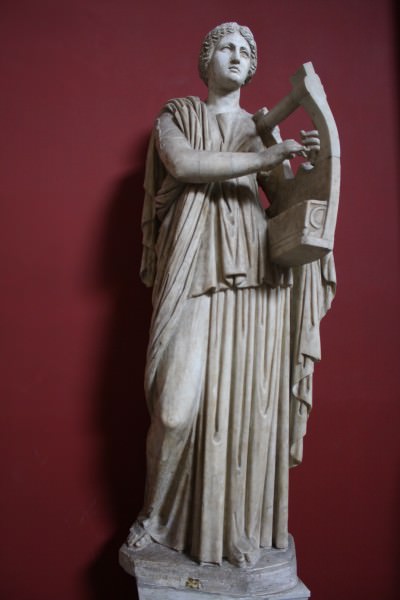
Erato
ERATO
The Muse of singing.

Eros
EROS
The forever youthful primaeval god of passionate desire, who brings irrepressible feelings and wild impulses to whoever his loosely aimed arrows hit. Assistant to Aphrodite, he was the protector of homosexual love.

Europa & Zeus
EUROPA
The daughter of Phoenician king Agenor or Phoenix, who was abducted by Zeus who transformed himself into a bull. Arriving on Crete, the couple had three children: Minos, Rhadamanthys, and Sarpedon. Zeus gave her a hound who always got its quarry, Talos the bronze man, and a javelin which always hit its target. Europa later married the Cretan king Asterius.
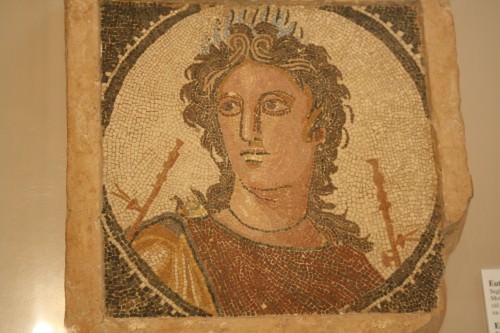
Roman Mosaic of Euterpe
EUTERPE
The Muse of lyric poetry and often portrayed playing a double aulos or flute.

Atropos, One of the Fates
FATES (AKA MOIRAI)
The three goddesses who personified Fate. They were Clotho, Lachesis and Atropos, and were daughters of Zeus and Themis.

Fury, Phaedra & Hippolytos
FURIES
Winged creatures, born from the blood of Uranus, who punish the wicked by dispensing disease and madness. Daughters of Earth and Sky, they also protected senior family members.

Gaia & Erichthonius
GAIA
The primaeval earth goddess. With Tartarus, she gave birth to the monster Typhon. In art, a popular depiction is Gaia giving the baby Ericthonius (an Athenian hero) to Athena.

Ganymede & Eagle
GANYMEDE
The handsome Trojan prince who caught Zeus' eye and was transported by the god (or his eagle) to Olympus where he serves as a cup-bearer.

Leto Fighting Giants
GIANTS
Born from Ge and the blood of Gaia or Uranus, these unruly and immensely strong creatures fought the Olympian gods but were defeated when the latter had help from Hercules. This battle, the Gigantomachy, was a popular subject in Greek temple sculpture. Their number included Pallas, Alcyoneus, Porphyrion, Polybotes, Ephialtes, Hippolytus, Enceladus and Eurytus.They were all either killed or imprisoned beneath the volcanoes of Greece and Italy.

Gorgon, Temple of Artemis, Corcyra
GORGONS
The three monstrous sisters - Medusa, Stheno and Euryale - whose stare could turn onlookers into stone. In Archaic art, they have sharp teeth and flowing locks of snakes, but in later times they are portrayed as beautiful women. They frequently appear on temple pediments, shields, and armour.

Perseus & the Graeae
GRAEAE
The three sisters who share one tooth and one eye between them. The hero Perseus consulted them on the whereabouts of Medusa and got his answer by stealing their eye. They were the daughters of Phorcys and Ceto, and are named as Pemphredo, Enyo and Deino.
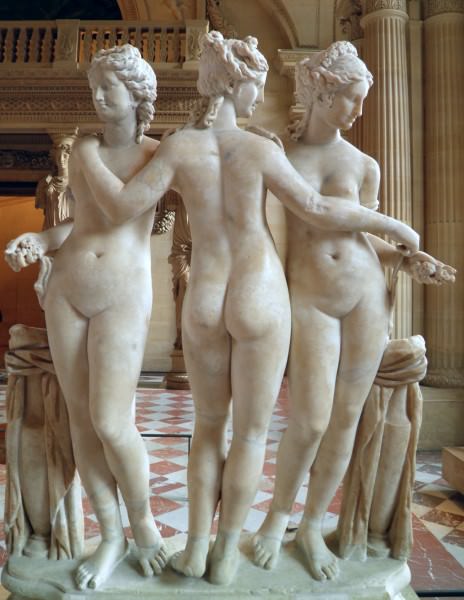
The Three Graces
GRACES
Three (or more) goddesses who personified charm, grace, and beauty in all its forms from the aesthetic to the intellectual.Offspring of Zeus and Eurynome, they were also accomplished at poetry, dancing, and music, and particularly associated with spring flowers.

Persephone & Hades
HADES
The name of the Underworld and the god who ruled it. Brother of Zeus and Poseidon, Hades abducted Persephone, tricking her with a pomegranate, but was compelled to give her up for half the year. He may be represented holding a cornucopia - symbol of the life which comes from the soil - a staff, or riding a chariot pulled by black horses. Hades the place was not necessarily a place of suffering but conceived as the last resting place of the soul. However, very wicked people were taken by the Furies down to the lowest level - Tartarus - and there received eternal torments.

Hecate
HECATE
The moon goddess associated with witchcraft, magic, doorways, and creatures of the night - especially hounds and ghosts.Hesiod makes her daughter of Perses and Asteria. She is often depicted with three faces representing her role as guardian of crossroads.
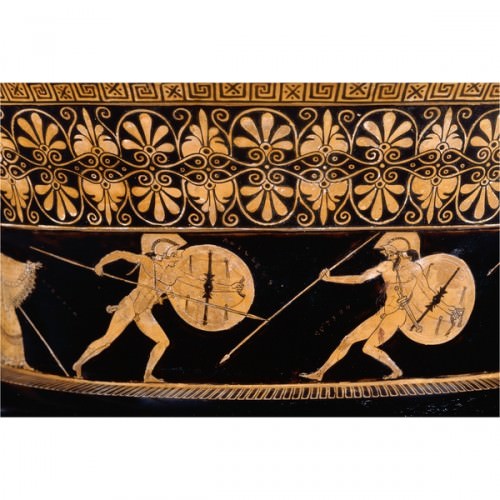
Achilles Fighting Hektor
HECTOR
The wise and noble son of the Trojan king Priam; he is the great hero of the city but falls at the hands of Achilles during the Trojan War. In vengeance for his killing of Patroclus, his body is dragged around the city walls behind the chariot of his slayer.Priam successfully appeals to Achilles for the restoration of his son's body whose funeral closes the Iliad.

Helios
HELIOS
The god of the sun who rode his golden chariot across the skies each day. Son of the titans Hyperion and Theia, he was famously represented by the Colossus of Rhodes, one of the Seven Wonders of the ancient world.

Hephaistos / Vulcan
HEPHAISTOS
The genius blacksmith and god of fire, metallurgy, and crafts, he was lame after he was thrown from Mt. Olympus by either Zeus or his mother Hera, upset at his ugliness. Husband of Aphrodite under false pretences, from his workshop on Mt. Etna he created such wonders as the aegis of Zeus, the helmet of Hermes, the first woman Pandora, and the great shield of Achilles.

Head of Hera
HERA
The famously jealous wife of Zeus, often with good reason, she was the goddess of marriage and family. Representing the ideal woman and fidelity, the daughter of Kronos and Rhea would take awful revenge on many of her husband's lovers and resulting offspring, especially Hercules. Patron of Argos, she was the mother of Ares, Hephaistos, and Hebe, amongst others.

Hercules & The Nemean Lion
HERCULES
The semi-divine hero and son of Zeus and Alkmene, who performed such prodigious deeds that he won immortality and his place amongst the Olympian gods. His 12 mighty labours included slaying monsters like the Lernaean Hydra, the Stymphalian Birds, and the ferocious three-headed hound of Hades, Cerberus. He is usually portrayed in art carrying a huge club and wearing the skin he ripped from the Nemean Lion, another of his victims.

Hermes Ludovesi
HERMES
The herald and messenger of the gods was himself the god of trade, wealth, luck, language, thieves, and travel. Son of Zeus and Maia (daughter of Atlas ), he was an impish seeker of amusement but had a more serious role as leader of dead souls to the River Styx. Patron of the home, he is often depicted wearing winged sandals or hat and holding his herald's staff or kerykeion.
HESTIA
The virgin goddess of the hearth, who is the daughter of Kronos and Rhea.

Dionysos & the Horae
HORAE (AKA HOURS)
The daughters of Zeus and Themis, who personified the seasons. They are Eunomia (Good Order), Dike (Justice) and Eirene (Peace) with their mother as the fourth and representing Divine Law. The three sisters guard the gates of Mt. Olympus.

Bronze Head of Hypnos
HYPNOS
The son of Nyx (Night) and personification of Sleep, he lives in the Underworld. Often depicted as a winged youth, he touches the head of the tired with a branch or pours a magic liquid on them to induce slumber.

Daedalus & Icarus
ICARUS
The son of the master craftsman Daedalus, who flew too close to the sun and so the wax melted on his artificial wings fashioned by his father in order to escape King Minos of Crete. Falling into the sea and drowning, the stretch of waters in that area became known as the Icarian Sea, and then, when Hercules dragged the washed up body to an island, he renamed that place Icaria in honour of the fallen youth.

Ixion
IXION
The king of the Lapiths in Thessaly who, in order to avoid paying the handsome bridal gifts for his future wife Dia, prepared a trap for her father Eioneus. This was a concealed pit, at the bottom of which was a charcoal fire. Invited for absolution at Mt.Olympus following the murder of Eioneus, Ixion then attacked Hera. Zeus had fooled him, though, into thinking a cloud was actually Hera and then punished Ixion by having him tied to an ever-spinning wheel of fire in Hades.
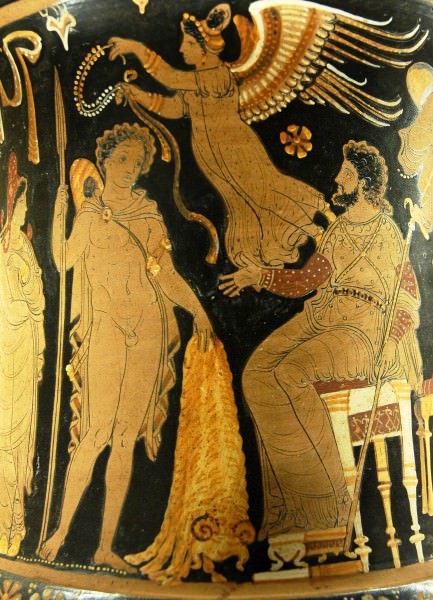
Jason brings Pelias the Golden Fleece
JASON
The hero whose father Aison had been robbed of his kingdom by Pelias, and when Jason came to claim his rightful inheritance, Pelias sent him on the impossible task of finding the Golden Fleece. Happy to oblige, Jason assembled his crew - the Argonauts of the ship Argo - and, with help from Athena, brought back the Fleece to Thessaly along with his sweetheart Medea. Pelias refused to give up the throne, Medea killed him with a potion, and the couple settled, in any case, in Corinth.

Kronos/Saturn
KRONOS (AKA CRONUS)
The Titan who was the son of Uranus and Gaia. He killed and castrated his father and then married his sister Rhea to produce the Olympian gods. Afraid he would be overthrown like his father, Kronos devoured all of his children, but Rhea saved Zeus, whom she hid on Crete, giving her husband a rock as a substitute. Gaia contrived for Kronos to cough up his children, who, led by Zeus, promptly did overthrow him. Kronos was then imprisoned in Tartarus. In other versions, he is king of a Golden Age and rules a land of paradise.

Leda & the Swan
LEDA
Leda was the queen of Sparta and mother of Clytemnestra. She was seduced by Zeus who took the form of a swan, and from this union was born Helen (from an egg) and the twins Castor and Pollux, the Dioscuri. In some versions, it is Nemesis who is seduced and Leda only looks after the egg and resulting offspring.

Zeus, Leto, Apollo & Artemis
LETO
Daughter of the Titans Coeus and Phoebe, she is the mother (with Zeus) of Apollo and Artemis, giving birth to her offspring on the island of Delos, hence its important sanctuary to Apollo.
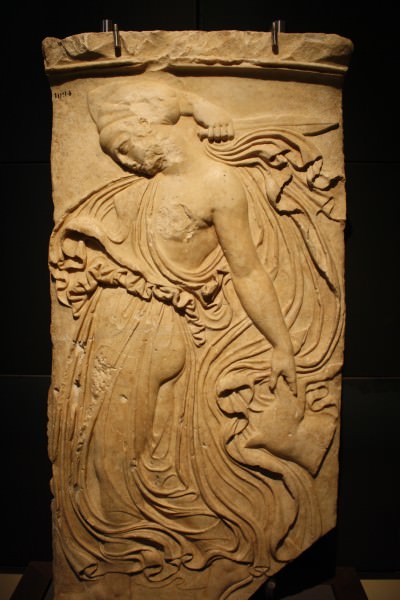
Maenad
MAENADS
The female followers of Dionysos who participated in frenzied rituals of dancing and music.

Marsyas, detail from NAM, Athens, 215.
MARSYAS
The satyr who was gifted at playing the aulos but, after foolishly challenging Apollo to a musical competition, lost and was flayed alive for his troubles.

Medea kills her son
MEDEA
The daughter of Aeetes, king of Colchis and granddaughter of Helios, she was skilled in the arts of magic and potions. She helped Jason steal the Golden Fleece by charming the dragon which protected it. She then hampered the pursuit of the Argonauts by dismembering her young brother Apsyrtus. In another shocking episode, she tricked Pelias' daughters into chopping him up and boiling him in a big pot as a punishment from Hera. Medea fled to Corinth with Jason, but rebuffed by the hero, she killed his new love Glauke and then her own children in spite. Fleeing again, this time in a dragon-pulled chariot to Athens, she would later try to poison Theseus, thus fully completing her reputation as an all-round bad egg.

Roof Ornament with Medusa's Head
MEDUSA
The gorgon whose stare turned onlookers to stone. She had once been very beautiful but was transformed into a hideous gorgon by Athena after she had been raped by Poseidon in one of the goddess' temples. Killed by the hero Perseus, from the blood of her decapitated torso sprang Chrysaor and the winged horse Pegasus.

Roman Sarcophagus (Detail)
MELEAGER
He was a hero who successfully led an all-star expedition to hunt and kill the Calydonian boar which had been terrorising central Greece. Known as an all-round good egg, he had also been one of the argonauts with Jason who found the Golden Fleece.

Melpomene
MELPOMENE
The Muse of tragedy plays, hence usually portrayed holding a tragedy theatre mask.
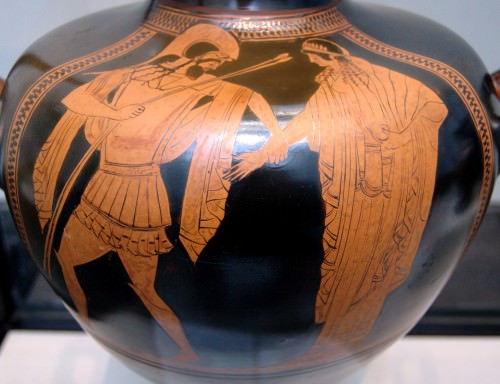
Menelaos & Helen
MENELAOS
The younger brother of Agamemnon, and the king of Sparta whose wife Helen ran off with Paris sparking the Trojan War. He survived the conflict and eventually returned home via Egypt.
METIS
The first wife of Zeus and personification of Intelligence. Zeus swallowed her as he feared she was pregnant with a child who would overthrow him. From this action sprang Athena, born from the god's head.

Red-Figure Stamnos Depicting Midas
MIDAS
The king of Phrygia who had the knack of changing anything he touched into gold, a skill he received from Dionysos in thanks for looking after the satyr Silenus. A less favourable trait were his donkey ears, given to him by Apollo after Midas had judged Pan the better musician of the two.
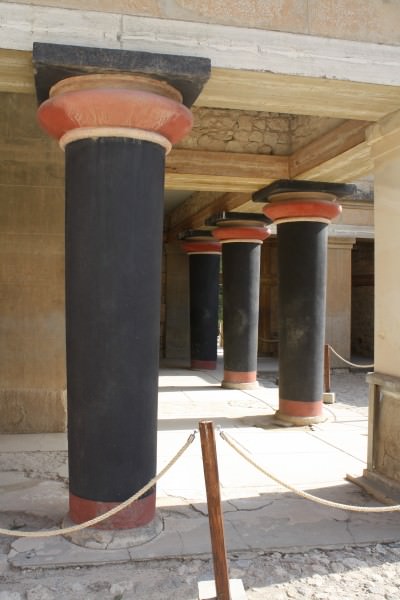
Labyrinth of Knossos
MINOS
The king of Crete whose palace at Knossos contained the labyrinth and Minotaur. The terrible half-man, half-bull creature was the fruit of Minos' wife Pasiphae's amorous engagement with a bull sent by Poseidon to punish the king for not sacrificing a prize bull to the god as promised. Minos extracted yearly tribute from Athens in the form of young men and women who were sacrificed to the Minotaur, but the hero Theseus managed to slay the Minotaur and end the practice. Minos was the son of Zeus and Europa but was mortal as his sticky end reveals. Falling out with Daedalus, the architect of his labyrinth, the king pursued him to Camicus but was boiled in his bath by the king's daughters there. In the afterlife, he was made a judge of souls along with his brother Rhadamanthys.

Minotaur
MINOTAUR
The half-man, half-bull creature which was the fruit of Minos' wife Pasiphae's amorous involvement with a bull sent by Poseidon. Haunting the labyrinth of Knossos, he would be killed by the Athenian hero Theseus, keen to put an end to the yearly sacrificial offerings of young men and women.
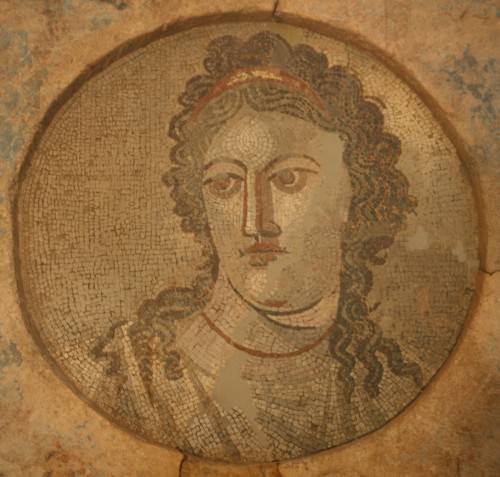
Roman Mosaic of Mnemosyne
MNEMOSYNE
The Titan who was the personification of Memory and mother of the nine Muses.
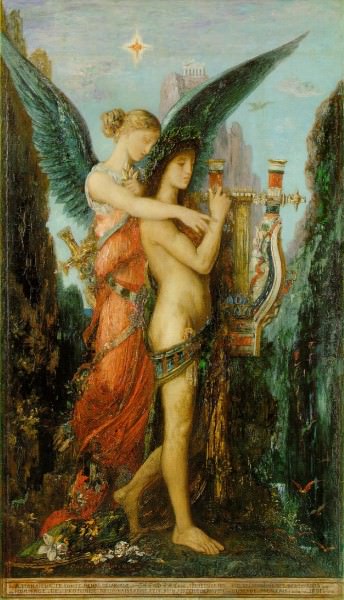
Hesiod and the Muse
MUSES
Nine masters of the arts. Daughters of Zeus and Memory (Mnemosyne), they gave the arts to mankind so that they might forget their troubles and to inspire artists of all kinds. They were: Calliope, Clio, Erato, Euterpe, Melpomene, Polymnia, Terpsichore, Thalia, and Urania.
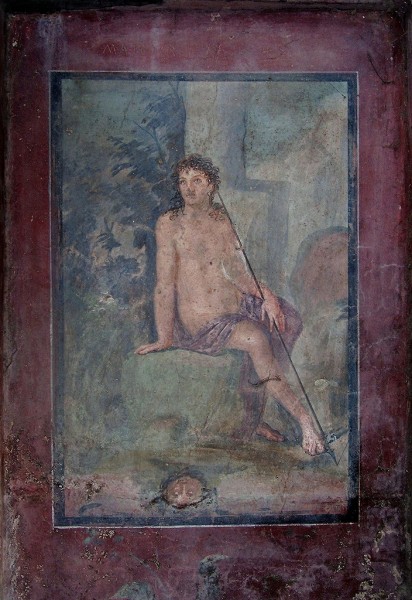
Narcissus Fresco, Pompeii
NARCISSUS
The young hunter from Thespiae in Boeotia, he was the son of Cephissus and the nymph Liriope. The impossibly handsome youth one day fell in love with his own reflection in a pool of water in the forest. Pining away from thirst and despair, and ignoring the attentions of Echo, he died but was transformed into a flower of the same name. Narcissus was especially popular in Roman art and appears in over 50 wall paintings at Pompeii.

Nemesis
NEMESIS
Both a goddess and the personification of retribution. Daughter of Oceanus and Night, she is relentless and merciless, especially punishing hubris.

Nereid Rising from the Ocean on a Horse
NEREID
The sea nymphs who are the daughters of Nereus. They can assist sailors and are often in the company of Poseidon.
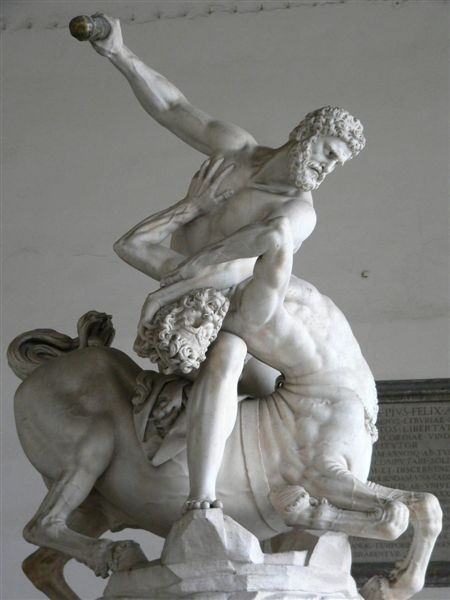
Hercules Fighting the Centaur Nessos
NESSUS
The centaur who unwisely picked a fight with Hercules and was struck by the hero's arrow for his troubles. In his revenge, though, Nessus tricked Hercules' wife Deianeira into using his blood which acted as a poison and killed his slayer when Deianeira coated her husband's cloak with it.

Nyx
NIGHT (AKA NYX)
Born from Chaos she personifies Night and is feared by both gods and men. Connected to oracles, she is also the mother of Sleep (Hypnos).
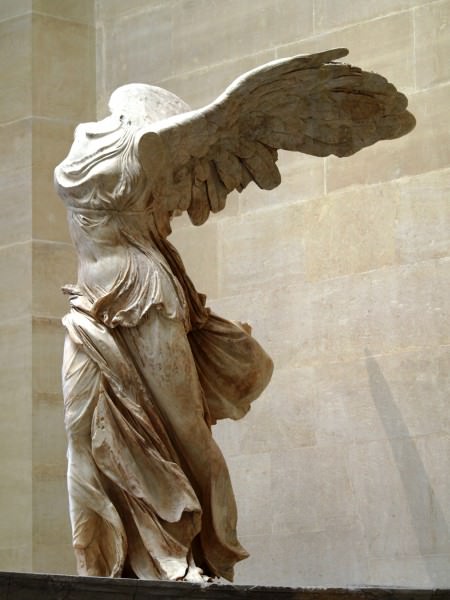
Nike of Samothrace
NIKE
The winged personification of Victory, whose father was the Titan Pallas and mother Styx. She was a popular subject in art, often accompanying Athena and famously represented in the statue from Samothrace and on the hand of the giant statue of Zeus at Olympia, one of the Seven Wonders of the ancient world.

Dying Niobid
NIOBE
The daughter of Tantalus and wife of Amphion of Thebes, she foolishly boasted that as she had so many children she was superior to Leto. The goddess promptly sent her children Apollo and Artemis to put Niobe in her place. Apollo killed all Niobe's sons with his bow, and Artemis did the same to the daughters. The distraught mother then became a rock on Mt. Sipylus which, washed continually with waters, mimicked Niobe's weeping forever.

Nymph with scoprion
NYMPH
Young females who hang around natural features such as rivers, springs, mountains, caves, and particular trees. They are often found in the company of Artemis and Pan, and they can help hunters and sailors but may be prone to abduction where handsome youths are concerned. If rebuffed, they could turn violent, as in the case of Echenais who blinded the Sicilian herdsman Daphnis.
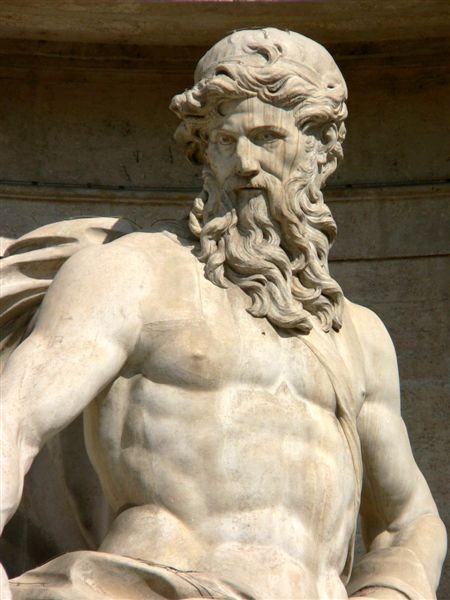
The Titan Oceanus
OCEANUS
The Titan son of Uranus and Gaia. His waters encircle the world and so is the source of all rivers. His wife is Tethys with whom he fathered the Oceanids and river-gods.

Odysseus and the Sirens
ODYSSEUS
The wily king of Ithaca known for his quick wits, courage, and leadership. The son of Laertes and Antikleia, he was instrumental in the Trojan War by persuading Achilles to join the cause and coming up with the ruse of the Trojan Horse. The voyage back home from Troy turned into an epic adventure and subject of Homer 's Odyssey. He encountered the Sirens, the Cylcops Polyphemos, visited Hades, and spent an age with the lovely Calypso, but eventually made it back to his faithful wife Penelope and son Telemachus.

Oedipus & the Sphinx
OEDIPUS
The king of Thebes who tragically confused his family relations, killing his father and, after solving the riddle of the sphinx, marrying his mother Epicaste (later Iocasta), both by mistake. Following his mother's suicide, and blinding himself for his stupidity, their descendants were cursed to endure many miseries. He is the subject of the famous tragedy named after him by Sophocles.

Mt. Olympus
OLYMPUS
The home of the Olympian gods and Greece's highest mountain at 2,918 m.

Orion
ORION
El poderoso cazador que era hijo de Poseidón y Euryale, una de las Gorgonas. Él famoso tuvo 50 hijos con 50 ninfas diferentes, trató de cortejar a Artemisa, y famoso persiguió a las Pléyades, pero fue asesinado por la diosa cazadora y transformado en una constelación de sus problemas. La apariencia, el ascenso y la caída de sus estrellas se usaron como una guía para cuándo realizar ciertas tareas agrícolas por antiguos agricultores.

Orpheus
ORFEO
Son of Apollo and the Muse Calliope, no wonder Orpheus was a virtuoso musician and poet. His lyre -playing calmed the Sirens on Jason's Argonaut expedition for the Golden Fleece and charmed Persephone to release from Hades his dead love Eurydice. He won his case but broke his promise not to look back on leaving the underworld and so his love was taken from him forever. Distraught, the great artist never played again, and he met a sticky end, ripped apart by the Maenads for being miserable.

Pan & Eros
PAN
The pastoral god who dwelt amongst the mountains, caves, and rivers of Greece. With the legs and horns of a goat, the patron of shepherds was the inventor and master of the syrinx or panpipes, which had been the nymph of the same name, but she panicked at Pan's attention and transformed herself into reeds, which the god then blew to create musical sounds.

Pandora
PANDORA
The first woman, made by Hephaistos (or in other versions Prometheus ) and beautified by the impressive team of Athena, Hermes, Aphrodite, and the Graces ; she opened the jar she was expressly told not to and so let out all the ills of the world leaving inside, caught on the lip, only one consolation: hope.

Pegasus, Corinthian Silver Stater
PEGASUS
The winged horse of Bellerophon, which was born from Zeus and the blood of Medusa. Pegasus helped the hero slay the Chimera and then enjoyed a semi-retirement on Mt. Olympus, where he brings Zeus' thunderbolt whenever required. The horse was a popular design on coins, especially those of Corinth.
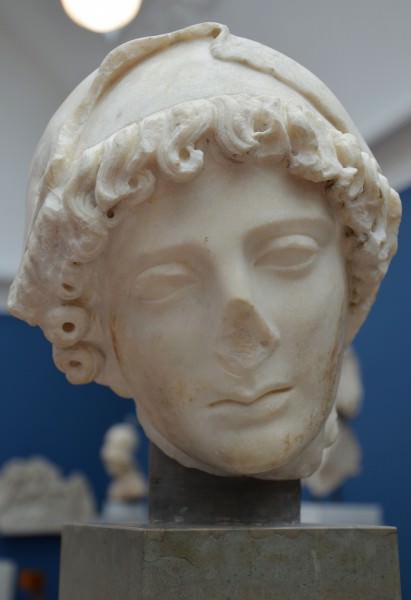
Head of Penelope
PENELOPE
The faithful wife of Odysseus, who warded off many suitors while her husband was fighting during the Trojan War and then dallying on his long odyssey home. One of her delaying tactics was to tell her suitors she first had to finish weaving a shroud for Odysseus' father Laertes, but each night she pulled out what she had woven that day. She is the mother of Telemachus.

Penthesilea & Achilles
PENTHESILEA
The amazon daughter of Otrere and Ares, who accidentally killed her colleague Hippolyte. She later led an army to assist Priam during the Trojan War but was killed by Achilles.
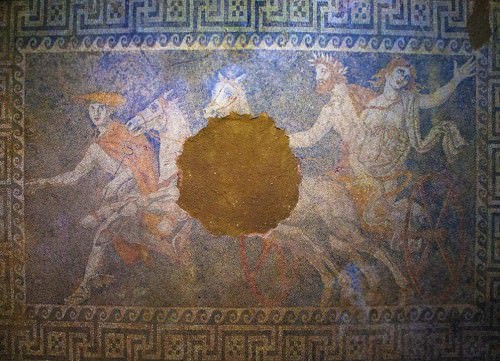
Persephone Mosaic, Amphipolis
PERSEPHONE (AKA KORE)
She was the goddess of vegetation, especially grain. Abducted by Hades to live with him in the Underworld, the beautiful goddess was eventually released, but by a trick of a pomegranate seed, she was compelled to return to Hades for a portion of the year. This was symbolic of the agricultural cycle or the common practice of burying seeds underground. Like her mother Demeter, she was an important focus of the Eleusinian Mysteries and Thesmophoria festival.
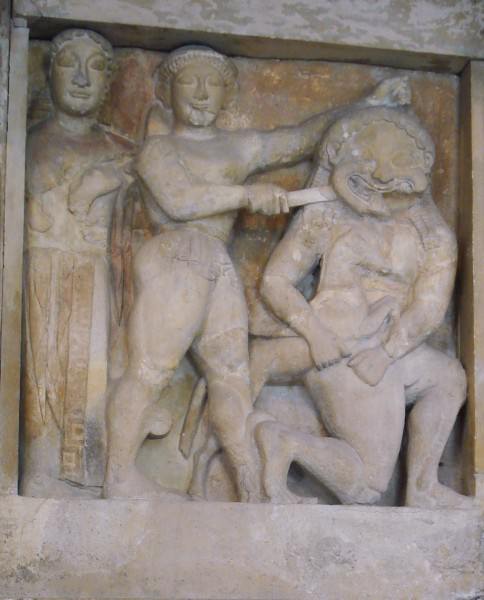
Perseus and Medusa
PERSEUS
Helped by Athena and given the invisible-making cap of Hades and a giant sword and winged sandals from Hermes, the hero made good on his rash promise to king Polydectes and beheaded Medusa. On his way home, he won the hand of fair Andromeda, the Ethiopian princess who was tied to a rock and left to Poseidon's dreadful sea-monster in punishment for her mother Cassiopeia's boast she was prettier than the Nereids, the sea-gods children. Using the head of Medusa, the hero turned the monster to stone and rescued Andromeda.

Pleiades Constellation
PLEIADES
The seven daughters of Atlas and the nymph Pleione, who, pursued by the hunter Orion, were immortalised by Zeus and became the constellation of that name. The rising of the stars in May and descent in October/November were used as guides by ancient farmers for when to harvest and plough.

Head of Polyphemus
POLYPHEMUS
The one-eyed cyclops who captured Odysseus and his men in Homer's Odyssey. The giant was the son of Poseidon, and he ate two of his prize each morning and evening until Odysseus got him drunk and blinded him. In revenge, the cyclops cursed the hero to endure all manner of delays on his onward journey home.

Polymnia - Muse of Hymns
POLYMNIA
The Muse of hymns to the gods and heroes.
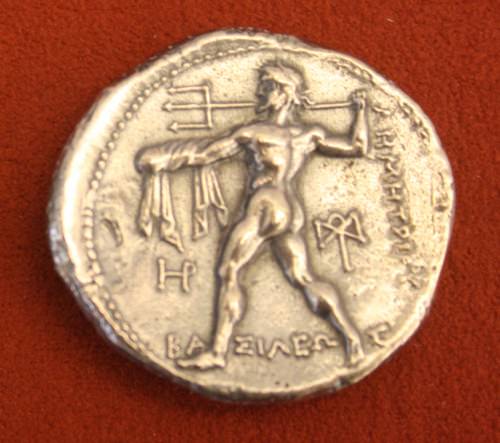
Macedonian Silver Tetradrachm
POSEIDON
The god of the sea and bringer of storms and earthquakes, he often meddled in the plans of his brother Zeus. Son of Kronos and Rhea, he had many children, including Theseus, was responsible for such monsters as the Minotaur, and had a temple at Sounion dedicated to him.

Lekythos with the Ransom of Hector Scene
PRIAM
The king of Troy who was the son of Laomedon and father of Hector and Paris (along with 48 other sons and several daughters, including Cassandra). He persuaded Achilles to return Hector's body for proper burial with a moving speech in Homer's version of the Trojan War. The pious king was killed by Neoptolemus when his city was finally sacked.
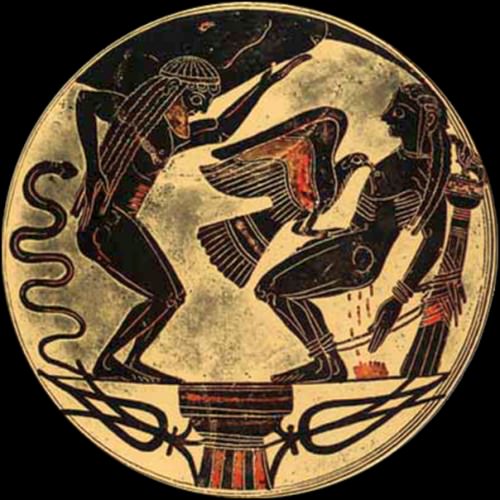
Prometheus & Atlas
PROMETHEUS
The trickster Titan who stole fire from the workshop of Hephaistos and gave it to mankind. Zeus punished him for his interference by having an eagle eat his liver every day after he was taken to the far away east where he was chained to a rock.After many years of this terrible fate, Prometheus was finally relieved by a passing Hercules who shot the eagle with an arrow.

Rhea Riding a Lion
RHEA
The Titan who was both sister and wife of Kronos, with whom she bore the Olympian gods. She protected Zeus by giving her husband a rock wrapped in cloth to swallow as a substitute after he had a mind to eat all his offspring.

Satyr
SATYR (AKA SILENS)
The lustful and wine-loving wild men of nature who had some animal features and followed Dionysos. Intelligent yet mischievous, the most famous of their number was Silenus, wise tutor of Dionysos.
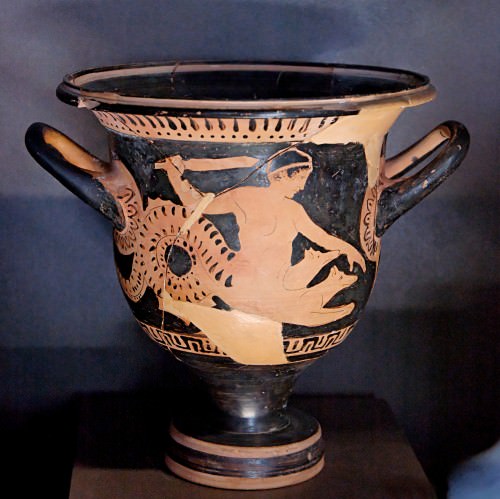
Scylla
SCYLLA
The monster which lived in a cave and preyed on passing sailors and sea-life going through the straits between Sicily and the Italian mainland. She had twelve feet, six heads, three rows of teeth and the bark of a dog. She is the daughter of Hecate.

Selene
SELENE
The moon goddess. She was the daughter of Hyperion (or Helios) and Theia, who fell in love with Endymion. Unfortunately, Zeus took a disliking to the handsome youth and set him to sleep forever in a cave on Mt. Latmus to be visited every now and then by the goddess (the dark phase of the Moon).

Silenus
SILENUS
The satyr who was father of all the other satyrs. He was the wise tutor of Dionysos.

Siren
SIREN
Half-bird half-woman creatures who lured sailors to their doom with beautiful singing. Odysseus famously avoided their call by tying himself to the mast of his ship when he passed their home near Scylla and Charybdis. With his escape they were fated to commit suicide, hence their frequent portrayal in art diving into the sea.

The Punishment of Sisyphus
SISYPHUS
The king of Corinth who cheated death twice by escaping Hades, the second time by arranging for his wife to forget the necessary funeral offerings to the gods. He lived to a ripe old age, but Zeus punished him for his impertinence by having him forever roll a stone up a hill when he reached the underworld for the third and last time.

Thetis Dipping Achilles into the River Styx
STYX
The eldest daughter of Oceanus and the personification of a river in Arcadia. Thetis, in one version of the myth, dipped Achilles into Styx's waters to make her son immortal. Later, she became the river that runs through Tartarus in the deepest part of the Underworld.

Talos
TALOS (AKA KALOS)
The bronze automaton made by Hephaistos to protect Europa, who then switched guard duties to Crete. He saw off trespassers by throwing large stones or heating himself red-hot and then embracing his victims. In some traditions he is killed by his jealous uncle Daedalus, in others, he is killed by Medea who released his magic life-source liquid, stored in his foot.

Tantalus
TANTALUS
The rich king of Sipylus who was granted the honour of dining with the gods but somehow disgraced himself, either by stealing the gods' ambrosia or tricking them into eating his son Pelops whom he had previously boiled. Zeus punished him for his wickedness in one of those delicious tortures he often dished out. Down in Hades, Tantalus had to stand in a pool of water which drained every time he tried to take a drink from it, and above him dangled fruit which withdrew from his reach each time he tried to grab one (hence the verb 'tantalise').
TARTARUS
The son of Gaia and Aether (Sky), he was the father of Typhon. It is also the name of the deepest level of Hades, where particularly wicked people like Sisyphus and Tantalus were punished, and where the unruly Titans are imprisoned.

Terpsichore
TERPSICHORE
The Muse of dance.

Tethys
TETHYS
The Titan daughter of Gaia and Uranus who represented rivers along with her brother and consort Oceanus. She was the mother of the Oceanids (sea nymphs).
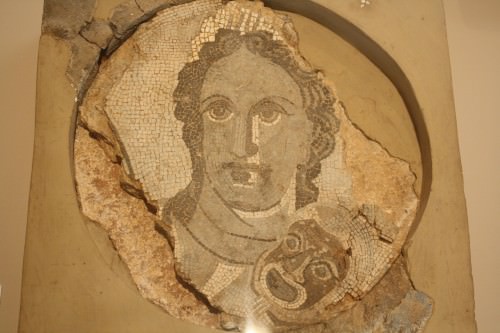
Roman Mosaic of Thalia
THALIA
The Muse of comedy theatre, hence usually depicted holding a comic theatre mask.

Themis
THEMIS
The primordial goddess, daughter of Gaia and Uranus, who was associated with prophecies, laws, and justice. Hesiod makes her the second wife of Zeus with whom she bore the Hours and Fates.
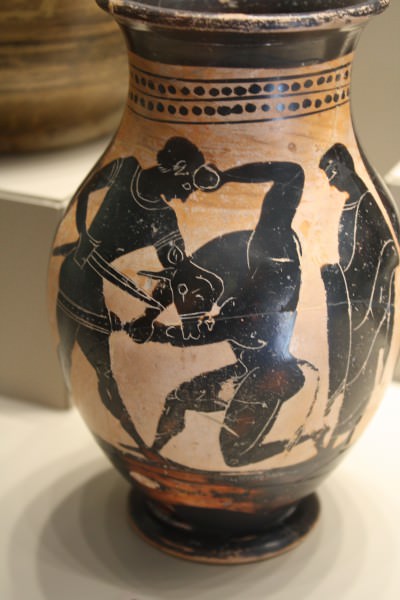
Theseus & the Minotaur
THESEUS
The hero king of Athens who battled Amazons, centaurs, various villains, and most impressive of all, the Minotaur that dwelt in King Minos' labyrinth on Crete. He slew the dreadful creature and escaped the maze by using a ball of twine given to him by Ariadne. Tragically, on the return home, the hero forgot to change his sail from black to white and so his father Aegeus thought him dead and threw himself into the sea, thereafter known as the Aegean in his honour.
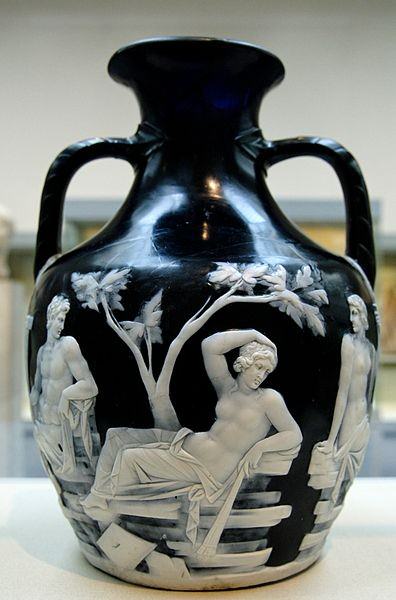
Portland Vase
THETIS
The sea nymph who was the daughter of Nereus, wife of Peleus, and mother of Achilles. She transformed herself into many forms while her husband-to-be courted her but their eventual wedding was attended by the gods. She famously dipped her son into the River Styx (or held him over a sacred flame) to make him invincible with only his heel where she held him being left mortal.
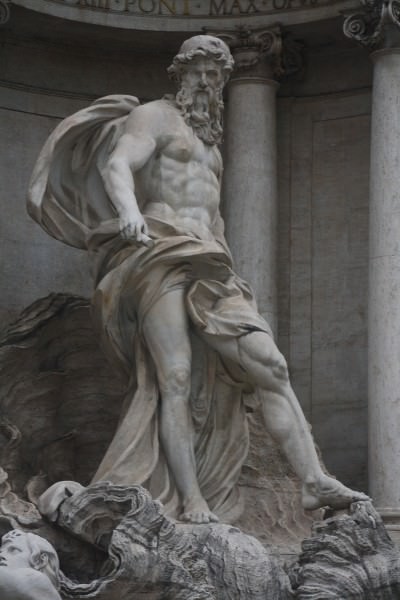
Titan
TITANS
The 12 terrible and mighty Titans preceded the Olympian gods with whom they battled for control of the universe and lost.Zeus then imprisoned them in Tartarus, the deepest part of Hades. Amongst their number were Kronos, Hyperion, Oceanus, and Rhea.
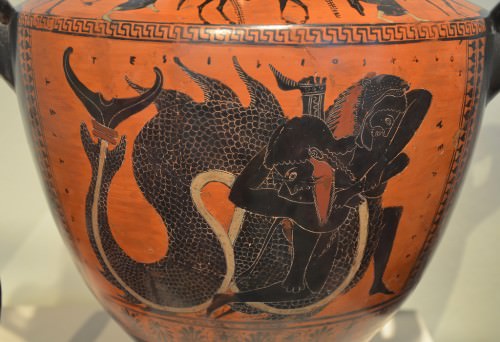
Herakles fighting Triton
TRITON
The fish-tailed monster who was the son of Poseidon and Amphitrite. He fought with Hercules but also helped Theseus. In Greek art, he sometimes blows a conch shell and his offspring carry the same name.

Typhon
TYPHON
Born from Gaia and Tartarus, he is the monster with 100 fire-blowing snake heads which make all the sounds of the animal kingdom. Zeus struck him down with his thunderbolt and imprisoned him in Tartarus deep in Hades, but he still causes trouble such as the occasional typhoon.
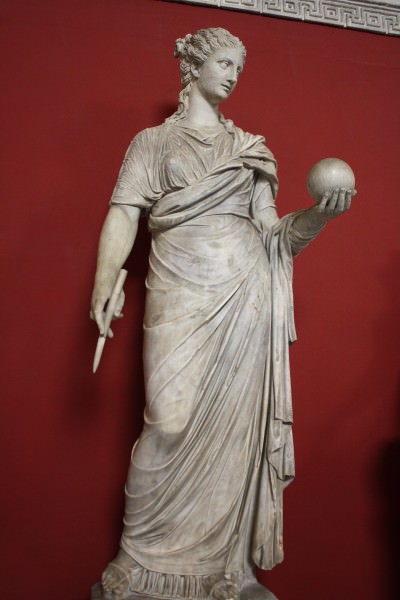
Urania
URANIA
The Muse of astronomy and so often depicting holding a sphere.
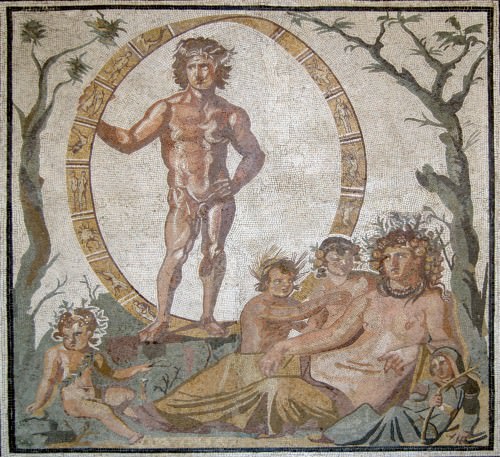
Uranus & Gaia
URANUS (AKA OURANOS)
The sky god who was born from Gaia. The pair marry and together they produce many other gods. One of these, Kronos, castrates his father and takes over his role as master of the universe. The genitalia of Uranus, cast into the sea, produces the goddess Aphrodite.

Zeus
ZEUS
The king of the Olympian gods and son of Kronos and Rhea, he was raised on Mt. Dikte, Crete by Gaia. He overthrew his father and, defeating both the Titans and Giants, he ruled supreme. Wedded to Hera but famously bedding many goddesses and mortals, he had numerous offspring, including Athena, Ares, Apollo, Hercules, and Perseus. He had an oracle at Dodona, a statue at Olympia (one of the Seven Wonders of the ancient world) and had the Olympic games held every four years in his honour. He is recognised in art by his thunderbolt.
LICENSE
Article based on information obtained from these sources:with permission from the Website Ancient History Encyclopedia
Content is available under License Creative Commons: Attribution-NonCommercial-ShareAlike 3.0 Unported. CC-BY-NC-SA License